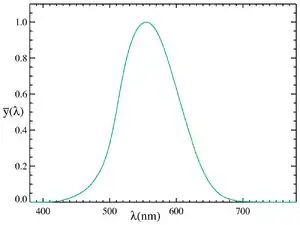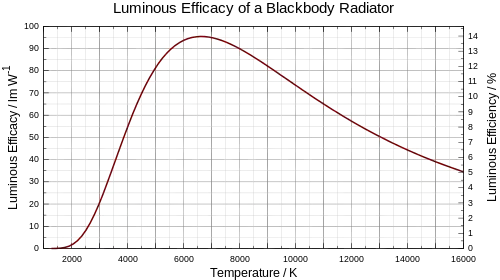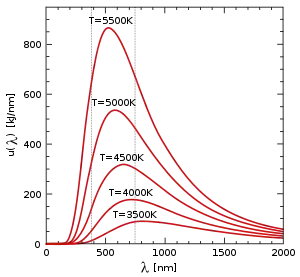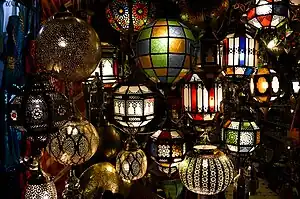Luminous efficacy
Luminous efficacy is a measure of how well a light source produces visible light. It is the ratio of luminous flux to power, measured in lumens per watt in the International System of Units (SI). Depending on context, the power can be either the radiant flux of the source's output, or it can be the total power (electric power, chemical energy, or others) consumed by the source.[1][2][3] Which sense of the term is intended must usually be inferred from the context, and is sometimes unclear. The former sense is sometimes called luminous efficacy of radiation,[4] and the latter luminous efficacy of a light source[5] or overall luminous efficacy.[6][7]
| Luminous efficacy | |
|---|---|
Common symbols | K |
| SI unit | lm⋅W−1 |
| In SI base units | cd⋅s3⋅kg−1⋅m−2 |
| Dimension | |
Not all wavelengths of light are equally visible, or equally effective at stimulating human vision, due to the spectral sensitivity of the human eye; radiation in the infrared and ultraviolet parts of the spectrum is useless for illumination. The luminous efficacy of a source is the product of how well it converts energy to electromagnetic radiation, and how well the emitted radiation is detected by the human eye.
Efficacy and efficiency
Luminous efficacy can be normalized by the maximum possible luminous efficacy to a dimensionless quantity called luminous efficiency. The distinction between efficacy and efficiency is not always carefully maintained in published sources, so it is not uncommon to see "efficiencies" expressed in lumens per watt, or "efficacies" expressed as a percentage.
Luminous efficacy of radiation
Explanation

Wavelengths of light outside of the visible spectrum are not useful for illumination because they cannot be seen by the human eye. Furthermore, the eye responds more to some wavelengths of light than others, even within the visible spectrum. This response of the eye is represented by the luminosity function. This is a standardized function which represents the response of a "typical" eye under bright conditions (photopic vision). One can also define a similar curve for dim conditions (scotopic vision). When neither is specified, photopic conditions are generally assumed.
Luminous efficacy of radiation measures the fraction of electromagnetic power which is useful for lighting. It is obtained by dividing the luminous flux by the radiant flux.[4] Light with wavelengths outside the visible spectrum reduces luminous efficacy, because it contributes to the radiant flux while the luminous flux of such light is zero. Wavelengths near the peak of the eye's response contribute more strongly than those near the edges.
Photopic luminous efficacy of radiation has a maximum possible value of 683.002 lm/W, for the case of monochromatic light at a wavelength of 555 nm (green). Scotopic luminous efficacy of radiation reaches a maximum of 1700 lm/W for monochromatic light at a wavelength of 507 nm.
Mathematical definition
Luminous efficacy, denoted K, is defined as[4]
where
- Φv is the luminous flux;
- Φe is the radiant flux;
- Φe,λ is the spectral radiant flux;
- K(λ) = KmV(λ) is the spectral luminous efficacy.
Photopic vision
| Type | Luminous efficacy of radiation (lm/W) |
Luminous efficiency[note 1] |
|---|---|---|
| Tungsten light bulb, typical, 2800 K | 15[9] | 2% |
| Class M star (Antares, Betelgeuse), 3300 K | 30 | 4% |
| Black body, 4000 K, ideal | 54.7[note 2] | 8% |
| Class G star (Sun, Capella), 5800 K | 93[9] | 13.6% |
| Black-body, 7000 K, ideal | 95[note 2] | 14% |
| Black-body, 5800 K, truncated to 400–700 nm (ideal "white" source)[note 3] | 251[9][note 4][10] | 37% |
| Black-body, 5800 K, truncated to ≥ 2% photopic sensitivity range[note 5] | 292[10] | 43% |
| Black-body, 2800 K, truncated to ≥ 2% photopic sensitivity range[note 5] | 299[10] | 44% |
| Black-body, 2800 K, truncated to ≥ 5% photopic sensitivity range[note 6] | 343[10] | 50% |
| Black-body, 5800 K, truncated to ≥ 5% photopic sensitivity range[note 6] | 348[10] | 51% |
| Ideal monochromatic source: 555 nm | 683.002[11] | 100% |
Scotopic vision
| Type | Luminous efficacy
of radiation (lm/W) |
Luminous
efficiency[note 1] |
|---|---|---|
| Ideal monochromatic 507 nm source | 1699[12] or 1700[13] | 100% |


Lighting efficiency
Artificial light sources are usually evaluated in terms of luminous efficacy of the source, also sometimes called wall-plug efficacy. This is the ratio between the total luminous flux emitted by a device and the total amount of input power (electrical, etc.) it consumes. The luminous efficacy of the source is a measure of the efficiency of the device with the output adjusted to account for the spectral response curve (the luminosity function). When expressed in dimensionless form (for example, as a fraction of the maximum possible luminous efficacy), this value may be called luminous efficiency of a source, overall luminous efficiency or lighting efficiency.
The main difference between the luminous efficacy of radiation and the luminous efficacy of a source is that the latter accounts for input energy that is lost as heat or otherwise exits the source as something other than electromagnetic radiation. Luminous efficacy of radiation is a property of the radiation emitted by a source. Luminous efficacy of a source is a property of the source as a whole.
Examples
The following table lists luminous efficacy of a source and efficiency for various light sources. Note that all lamps requiring electrical/electronic ballast are unless noted (see also voltage) listed without losses for that, reducing total efficiency.
| Category | Type | Overall luminous efficacy (lm/W) |
Overall luminous efficiency[note 1] |
|---|---|---|---|
| Combustion | Gas mantle | 1–2[14] | 0.15–0.3% |
| Incandescent | 15, 40, 100 W tungsten incandescent (230 V) | 8.0, 10.4, 13.8[15][16][17][18] | 1.2, 1.5, 2.0% |
| 5, 40, 100 W tungsten incandescent (120 V) | 5.0, 12.6, 17.5[19] | 0.7, 1.8, 2.6% | |
| Halogen incandescent | 100, 200, 500 W tungsten halogen (230 V) | 16.7, 17.6, 19.8[20][18] | 2.4, 2.6, 2.9% |
| 2.6 W tungsten halogen (5.2 V) | 19.2[21] | 2.8% | |
| Halogen-IR (120 V) | 17.7–24.5[22] | 2.6–3.5% | |
| Tungsten quartz halogen (12–24 V) | 24 | 3.5% | |
| Photographic and projection lamps | 35[23] | 5.1% | |
| Light-emitting diode | LED screw base lamp (120 V) | 102[24][25][26] | 14.9% |
| 5–16 W LED screw base lamp (230 V) | 75–210[27][28] | 11–30% | |
| 21.5 W LED retrofit for T8 fluorescent tube (230 V) | 172[29] | 25% | |
| Theoretical limit for a white LED with phosphorescence color mixing | 260–300[30] | 38.1–43.9% | |
| Arc lamp | Carbon arc lamp | 2–7[31] | 0.29–1.0% |
| Xenon arc lamp | 30–90[32][33][34] | 4.4–13.5% | |
| Mercury-xenon arc lamp | 50–55[32] | 7.3–8% | |
| Ultra-high-pressure (UHP) mercury-vapor arc lamp, free mounted | 58–78[35] | 8.5–11.4% | |
| Ultra-high-pressure (UHP) mercury-vapor arc lamp, with reflector for projectors | 30–50[36] | 4.4–7.3% | |
| Fluorescent | 32 W T12 tube with magnetic ballast | 60[37] | 9% |
| 9–32 W compact fluorescent (with ballast) | 46–75[18][38][39] | 8–11.45%[40] | |
| T8 tube with electronic ballast | 80–100[37] | 12–15% | |
| PL-S 11 W U-tube, excluding ballast loss | 82[41] | 12% | |
| T5 tube | 70–104.2[42][43] | 10–15.63% | |
| 70–150 W inductively-coupled electrodeless lighting system | 71–84[44] | 10–12% | |
| Gas discharge | 1400 W sulfur lamp | 100[45] | 15% |
| Metal-halide lamp | 65–115[46] | 9.5–17% | |
| High-pressure sodium lamp | 85–150[18] | 12–22% | |
| Low-pressure sodium lamp | 100–200[18][47][48] | 15–29% | |
| Plasma display panel | 2–10[49] | 0.3–1.5% | |
| Cathodoluminescence | Electron-stimulated luminescence | 30–110[50][51] | 15% |
| Ideal sources | Truncated 5800 K black-body[note 4] | 251[9] | 37% |
| Green light at 555 nm (maximum possible luminous efficacy by definition) | 683.002[11] | 100% |
Sources that depend on thermal emission from a solid filament, such as incandescent light bulbs, tend to have low overall efficacy because, as explained by Donald L. Klipstein, "An ideal thermal radiator produces visible light most efficiently at temperatures around 6300 °C (6600 K or 11,500 °F). Even at this high temperature, a lot of the radiation is either infrared or ultraviolet, and the theoretical luminous [efficacy] is 95 lumens per watt. No substance is solid and usable as a light bulb filament at temperatures anywhere close to this. The surface of the sun is not quite that hot."[23] At temperatures where the tungsten filament of an ordinary light bulb remains solid (below 3683 kelvin), most of its emission is in the infrared.[23]
SI photometry units
| Quantity | Unit | Dimensions [nb 1] |
Notes | |||||
|---|---|---|---|---|---|---|---|---|
| Name | Symbol[nb 2] | Name | Symbol | |||||
| Luminous energy | Qv[nb 3] | lumen second | lm⋅s | T J | The lumen second is sometimes called the talbot. | |||
| Luminous flux, luminous power | Φv[nb 3] | lumen (= candela steradian) | lm (= cd⋅sr) | J | Luminous energy per unit time | |||
| Luminous intensity | Iv | candela (= lumen per steradian) | cd (= lm/sr) | J | Luminous flux per unit solid angle | |||
| Luminance | Lv | candela per square metre | cd/m2 (= lm/(sr⋅m2)) | L−2J | Luminous flux per unit solid angle per unit projected source area. The candela per square metre is sometimes called the nit. | |||
| Illuminance | Ev | lux (= lumen per square metre) | lx (= lm/m2) | L−2J | Luminous flux incident on a surface | |||
| Luminous exitance, luminous emittance | Mv | lumen per square metre | lm/m2 | L−2J | Luminous flux emitted from a surface | |||
| Luminous exposure | Hv | lux second | lx⋅s | L−2T J | Time-integrated illuminance | |||
| Luminous energy density | ωv | lumen second per cubic metre | lm⋅s/m3 | L−3T J | ||||
| Luminous efficacy (of radiation) | K | lumen per watt | lm/W | M−1L−2T3J | Ratio of luminous flux to radiant flux | |||
| Luminous efficacy (of a source) | η[nb 3] | lumen per watt | lm/W | M−1L−2T3J | Ratio of luminous flux to power consumption | |||
| Luminous efficiency, luminous coefficient | V | 1 | Luminous efficacy normalized by the maximum possible efficacy | |||||
| See also: SI · Photometry · Radiometry | ||||||||
- The symbols in this column denote dimensions; "L", "T" and "J" are for length, time and luminous intensity respectively, not the symbols for the units litre, tesla and joule.
- Standards organizations recommend that photometric quantities be denoted with a subscript "v" (for "visual") to avoid confusion with radiometric or photon quantities. For example: USA Standard Letter Symbols for Illuminating Engineering USAS Z7.1-1967, Y10.18-1967
- Alternative symbols sometimes seen: W for luminous energy, P or F for luminous flux, and ρ for luminous efficacy of a source.
See also
- Photometry
- Light pollution
- Wall-plug efficiency
- Coefficient of utilization
- List of light sources
- SI defining constants, including Kcd (used in the definition of candela)
Notes
- Defined such that the maximum possible luminous efficacy corresponds to a luminous efficiency of 100%.
- Black body visible spectrum
- Most efficient source that mimics the solar spectrum within range of human visual sensitivity.
- Integral of truncated Planck function times photopic luminosity function times 683.002 lm/W.
- Omits the part of the spectrum where the eye's sensitivity is very poor.
- Omits the part of the spectrum where the eye's sensitivity is low (≤ 5% of the peak).
References
- Allen Stimson (1974). Photometry and Radiometry for Engineers. New York: Wiley and Son. Bibcode:1974wi...book.....S.
- Franc Grum; Richard Becherer (1979). Optical Radiation Measurements, Vol 1. New York: Academic Press.
- Robert Boyd (1983). Radiometry and the Detection of Optical Radiation. New York: Wiley and Son.
- International Electrotechnical Commission (IEC): International Electrotechnical Vocabulary, ref. 845-21-090, Luminous efficacy of radiation (for a specified photometric condition)
- International Electrotechnical Commission (IEC): International Electrotechnical Vocabulary, ref. 845-21-089, Luminous efficacy (of a light source)
- Roger A. Messenger; Jerry Ventre (2004). Photovoltaic systems engineering (2 ed.). CRC Press. p. 123. ISBN 978-0-8493-1793-4.
- Erik Reinhard; Erum Arif Khan; Ahmet Oğuz Akyüz; Garrett Johnson (2008). Color imaging: fundamentals and applications. A K Peters, Ltd. p. 338. ISBN 978-1-56881-344-8.
- ISO (2005). ISO 23539:2005 Photometry — The CIE system of physical photometry (Report). Retrieved 2022-01-05.
- "Maximum Efficiency of White Light" (PDF). Retrieved 2011-07-31.
- Murphy, Thomas W. (2012). "Maximum spectral luminous efficacy of white light". Journal of Applied Physics. 111 (10): 104909–104909–6. arXiv:1309.7039. Bibcode:2012JAP...111j4909M. doi:10.1063/1.4721897. S2CID 6543030.
- "BIPM statement: Information for users about the proposed revision of the SI" (PDF). Archived (PDF) from the original on 21 January 2018. Retrieved 5 May 2018.
- Kohei Narisada; Duco Schreuder (2004). Light Pollution Handbook. Springer. ISBN 1-4020-2665-X.
- Casimer DeCusatis (1998). Handbook of Applied Photometry. Springer. ISBN 1-56396-416-3.
- Westermaier, F. V. (1920). "Recent Developments in Gas Street Lighting". The American City. New York: Civic Press. 22 (5): 490.
- "Philips Classictone Standard 15 W clear".
- "Philips Classictone Standard 40 W clear".
- "Bulbs: Gluehbirne.ch: Philips Standard Lamps (German)". Bulbs.ch. Retrieved 2013-05-17.
- Philips Product Catalog (German)
- Keefe, T.J. (2007). "The Nature of Light". Archived from the original on 2012-01-18. Retrieved 2016-04-15.
- "Osram halogen" (PDF). osram.de (in German). Archived from the original (PDF) on November 7, 2007. Retrieved 2008-01-28.
- "Osram 6406330 Miniwatt-Halogen 5.2V". bulbtronics.com. Archived from the original on 2016-02-13. Retrieved 2013-04-16.
- "GE Lighting HIR Plus Halogen PAR38s" (PDF). ge.com. Retrieved 2017-11-01.
- Klipstein, Donald L. (1996). "The Great Internet Light Bulb Book, Part I". Archived from the original on 2001-09-09. Retrieved 2006-04-16.
- "Toshiba E-CORE LED Lamp". item.rakuten.com. Retrieved 2013-05-17.
- "Toshiba E-CORE LED Lamp LDA5N-E17". Archived from the original on 2011-07-19.
- Toshiba to release 93 lm/W LED bulb Ledrevie
- "Philips - LED bulbs". Retrieved 2020-03-14.
- "LED CLA 60W A60 E27 4000K CL EELA SRT4 | null". www.lighting.philips.co.uk. Retrieved 2021-09-26.
- "MAS LEDtube 1500mm UE 21.5W 840 T8". Retrieved 2018-01-10.
- Zyga, Lisa (2010-08-31). "White LEDs with super-high luminous efficacy could satisfy all general lighting needs". Phys.org. Retrieved 17 November 2021.
- "Arc Lamps". Edison Tech Center. Retrieved 2015-08-20.
- "Technical Information on Lamps" (PDF). Optical Building Blocks. Retrieved 2010-05-01. Note that the figure of 150 lm/W given for xenon lamps appears to be a typo. The page contains other useful information.
- OSRAM Sylvania Lamp and Ballast Catalog. 2007.
- "XENARC ORIGINAL D1S | OSRAM Automotive". www.osram.com. Retrieved 2021-09-30.
- REVIEW ARTICLE: UHP lamp systems for projection applications Journal of Physics D: Applied Physics
- OSRAM P-VIP PROJECTOR LAMPS Osram
- Federal Energy Management Program (December 2000). "How to buy an energy-efficient fluorescent tube lamp". U.S. Department of Energy. Archived from the original on 2007-07-02.
{{cite journal}}: Cite journal requires|journal=(help) - "Low Mercury CFLs". Energy Federation Incorporated. Archived from the original on October 13, 2008. Retrieved 2008-12-23.
- "Conventional CFLs". Energy Federation Incorporated. Archived from the original on October 14, 2008. Retrieved 2008-12-23.
- "Global bulbs". 1000Bulbs.com. Retrieved 2010-02-20.|
- Phillips. "Phillips Master". Retrieved 2010-12-21.
- Department of the Environment, Water, Heritage and the Arts, Australia. "Energy Labelling—Lamps". Archived from the original on July 23, 2008. Retrieved 2008-08-14.
{{cite web}}: CS1 maint: multiple names: authors list (link) - "BulbAmerica.com". Bulbamerica.com. Archived from the original on December 1, 2012. Retrieved 2010-02-20.
- SYLVANIA. "Sylvania Icetron Quicktronic Design Guide" (PDF). Retrieved 2015-06-10.
- "1000-watt sulfur lamp now ready". IAEEL newsletter. No. 1. IAEEL. 1996. Archived from the original on 2003-08-18.
- "The Metal Halide Advantage". Venture Lighting. 2007. Archived from the original on 2012-02-15. Retrieved 2008-08-10.
- "LED or Neon? A scientific comparison".
- "Why is lightning coloured? (gas excitations)". webexhibits.org.
- "Future Looks Bright for Plasma TVs" (PDF). Panasonic. 2007. Retrieved 2013-02-10.
- "TV-Tube Technology Builds an Efficient Light Bulb". OSA. 2019. Retrieved 2020-09-12.
- Sheshin, Evgenii P.; Kolodyazhnyj, Artem Yu.; Chadaev, Nikolai N.; Getman, Alexandr O.; Danilkin, Mikhail I.; Ozol, Dmitry I. (2019). "Prototype of cathodoluminescent lamp for general lighting using carbon fiber field emission cathode". Journal of Vacuum Science & Technology B. AVS. 37 (3): 031213. Bibcode:2019JVSTB..37c1213S. doi:10.1116/1.5070108. S2CID 155496503. Retrieved 2020-09-12.
External links
- Hyperphysics has these graphs of efficacy that do not quite comply with the standard definition
- Energy Efficient Light Bulbs
- Other Power

.jpg.webp)
